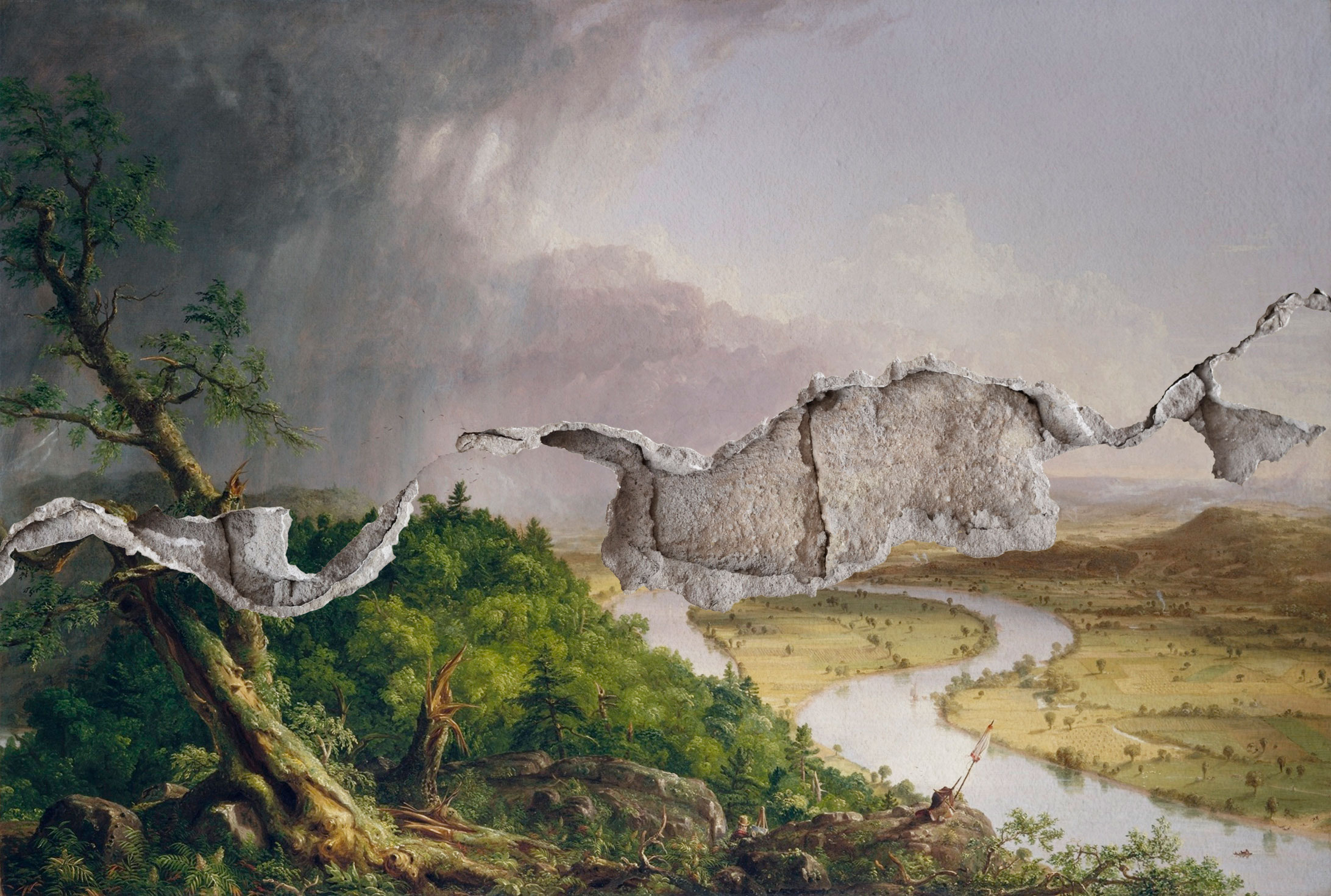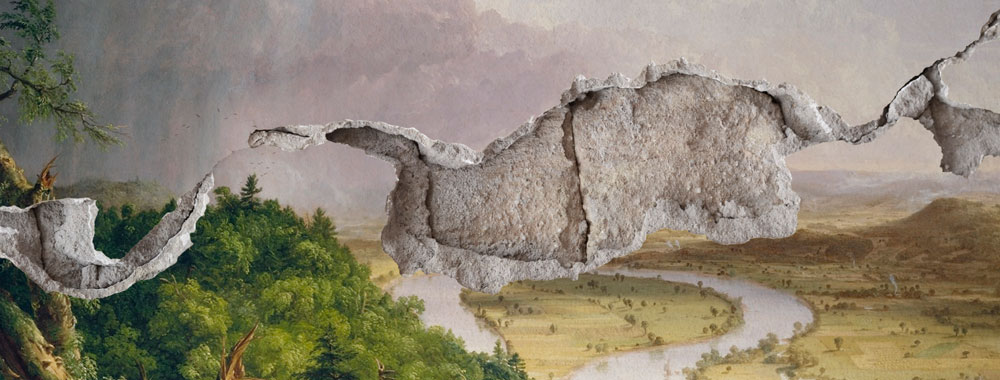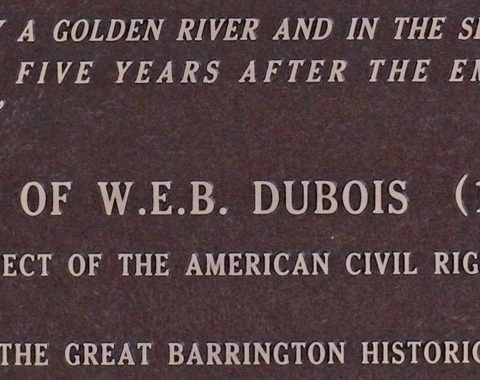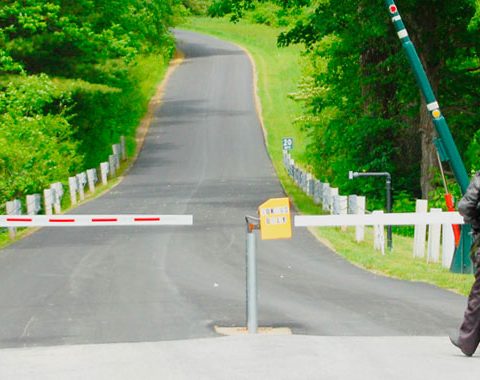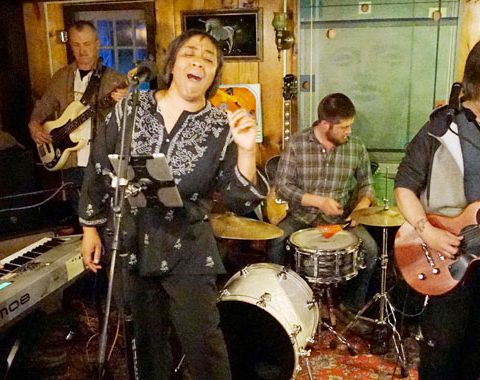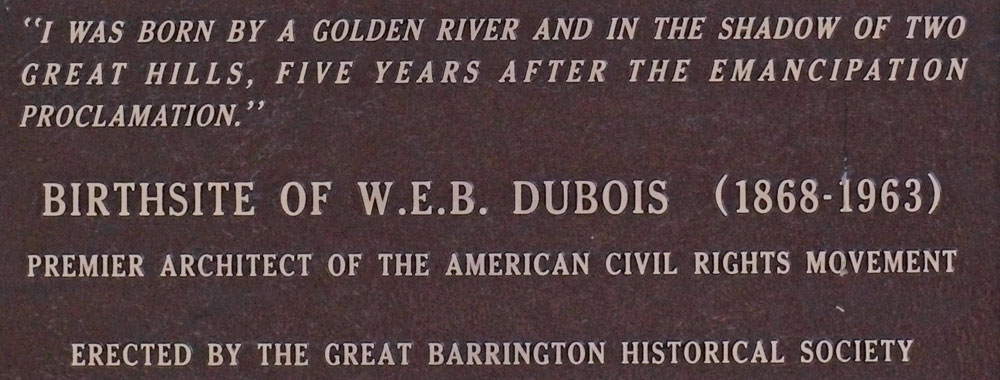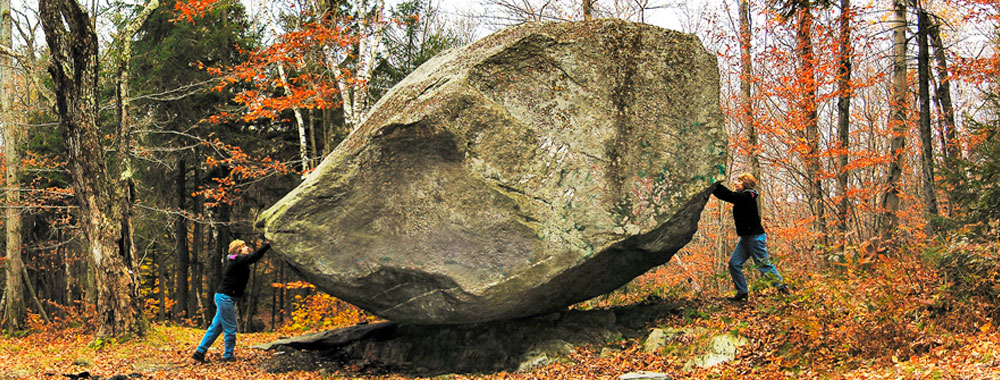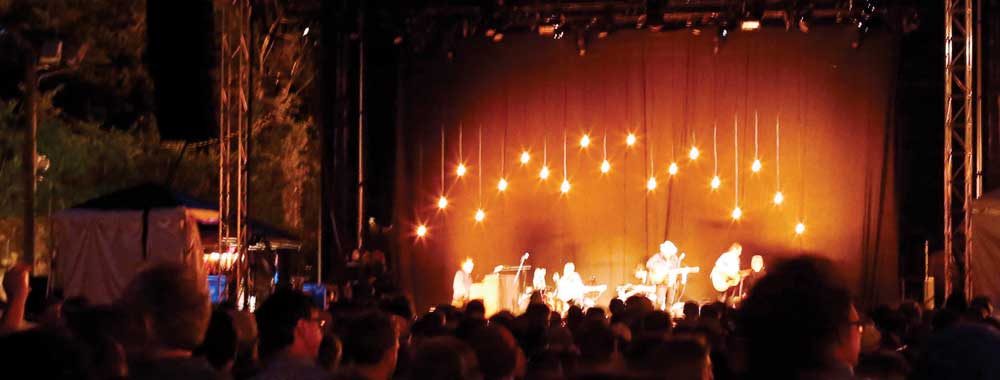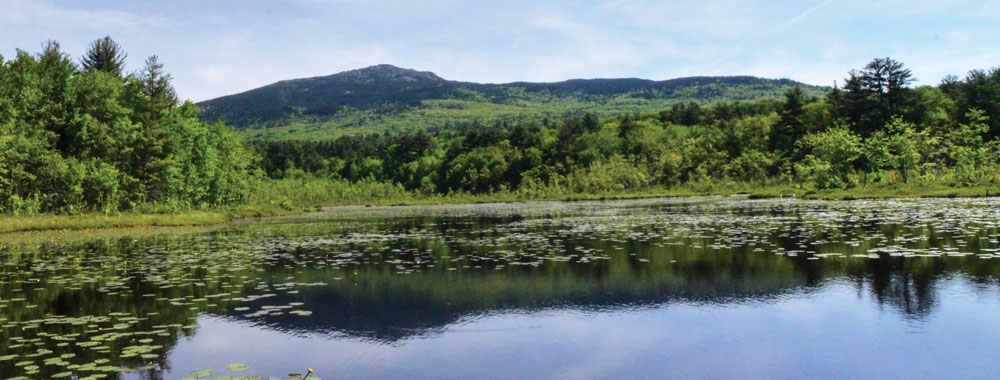The following essay originally appeared in the September 1979 issue of UpCountry Magazine.
By Richard Nunley
New Lebanon, N.Y.
Not far from where I live, a major U.S. route and state highway coincide for about half a mile. Along this stretch — its counterpart is doubtless near you, wherever you are — you will find, among other things, these physical entities: The replacement in permastone veneer of an 18th-century Congregational church which burned in 1940; a Japanese restaurant in a schloss-like mansion built by the nephew of the defeated presidential candidate in the election of 1876; an informally chic restaurant in a tall Italianate brick building originally a school and then a Grange hall; a metal-sided barbershop; the North American headquarters of a British coat manufacturer in a barn-red former greasy spoon; a rather oily expanse where a pill factory burned some years ago; a derelict granite building many suppose was a jail but which actually was where the pill company stored its chemicals; a rickety asphalt-sided house occupied by a wood-stove business run by a religious commune; an old grocery turned into an antique shop; a prefabricated steel firehouse and ambulance garage; a soft-ice-cream stand in the yard of an old farmhouse with a few now-unused tourist cabins slouching behind some low-limbed apple trees; an old roadhouse (with EARL’S spelled out in colored shingles on its mansard roof) which now houses a weekend flea market.; a large empty space where the sagging ruins of a nightclub built in the shape of a Mississippi River steamboat stood for several years after it burned until the town finally had it bulldozed away; a gas station-motel; a cornfield; a farmhouse; a wooden Gothic-revival house selling old furniture on the lawn in all weathers; a self-service gas station surrounded by a clutter of miscellaneous merchandise, dubious vehicles and propane cylinders.
Behind this strip heavily traveled by oil tankers, logging trucks, commercial and passenger traffic of every sort imaginable barreling through — 50 yards back on one side — prize Jerseys placidly graze. On the other side a wooded mountainside springs up in bounding beauty.
Question: Is this strip devoid of what Christopher Tunnard calls “environmental aesthetic value”? Is it, in other words, “landscape” or “blot on the landscape”?
“Blot!” almost everyone would unhesitatingly reply — or would have until fairly recently when a few planners, landscape architects and environmental historians began rethinking the traditional notions of what constitutes landscape value and scenic beauty. They became dissatisfied with the traditional concept of landscape, which increasingly was leading to the segregation of picturesque beauty over there somewhere, quite apart from the ordinary surroundings of most people’s daily lives, which were rapidly deteriorating and consequently being allowed to become more and more chaotic, self-defeating, debased and depressing. These observers began saying, “Wait a minute. Look a little closer at what’s behind this neglect, decay and abuse. It may not be conventional beauty, but there is value there which rewards attention.”
And sure enough, when, under the prompting of thinkers about landscape like Sheafe Satterthwaite, planning associate in environmental studies at Williams College, you look again at a place like this strip below my house, you begin to appreciate the uniqueness of its rather incredible incongruity. Merely inventorying it begins to alter your perception of it. You begin to see, as Satterthwaite says, that in its haphazard, thunderously existential way, it tells us something about the people who have lived here. Its visual appearance begins to tell the tale not only of its natural history but of its cultural history as well.
What it is begins to reveal to us, for instance: the impact and meaning or our devotion to the car, our demand for easy access, our insistence upon retaining our options to remain disengaged, mobile, private. And insofar as what we perceive with the understanding we tend to like, and what we like, tend to think beautiful, the strip does partake of a sort of beauty, although a far cry from the sort of beauty our long tradition of picturesqueness has readied us to appreciate.

But where have these new ideas of landscape come from? And where, for that matter, does our traditional enthusiasm for wild scenic beauty come from? Clearly it came from somewhere, for although, from the first, New Englanders were intensely aware of the looks of New England, they did not at first regard the scene as aesthetically pleasing or emotionally and spiritually uplifting. Edward Winslow, writing from Plymouth on Dec. 11, 1621, speaks of “so many miles together by goodly rivers” that he has seen here, but only to express his “grief” that there aren’t enough settlers to inhabit them and make use of them. And John Smith waxes lyrical in “A Description of New England” (1616) about what he has seen of the New England coast, but only as a real estate to develop. And of the White Mountains, to later generations the epitome of scenic beauty, John Josselyn in “New-Englands Rarities” (1672) could only say, “The Country is daunting terrible, being full of rocky Hills, as thick as Mole-hills in a Meadow, and cloathed with infinite thick Woods.”
How later generations acquired the taste for natural scenery is interestingly detailed by Christopher Tunnard’s last book, “A World with a View: An Inquiry into the Nature of Scenic Values” (Yale University Press, 1978). Tunnard, a professor of city planning at Yale for many years and until his death an international force in the struggle to preserve what he called mankind’s “cultural patrimony” (in which therm he includes areas of natural beauty like Bartholomew’s Cobble on the Housatonic), shows how the Romantic movement — and primarily Wordsworth — transformed in a single generation the way people looked at the natural scene from distaste or disinterest to almost religious fervor. This transformation in taste was as rapid as today’s jogging takeover. Marjorie Nicolson in “Mountain Gloom and Mountain Glory” (Norton, 1963) cites Wordsworth’s quotation of his old nurse: “Bless me! Folks are always talking about prospects; when I was young there never was sic a thing neamed!” Beautiful prospects rapidly came to embody man’s veneration of a purer past in a degraded present, to stand as reassurance of harmony and homogeneity in an area of discord and distressful change.
But William Cullen Bryant probable more than anyone else planted Wordsworthian admiration for natural scenery as one of the American pieties. A boy prodigy whose poems showed that America could produce just as good poems as Europe any old day, his refined and gently melancholy apostrophes to natural beauty like “Thantopsis” and “A Forest Hymn” were memorised by generations of schoolchildren and shaped their perception of their environment. They paved the way for paintings of his friends, Asher Durand and Thomas Cole, founders of the Hudson River School, although they painted as much in the Berkshires (“the American Lake District”) and the White Mountains (“the American Alps”) as along the Hudson (“the American Rhine”).
Thus was established our conventional conception of landscape as the almost holy real equivalent of the inspiring pictures on the gallery wall or in parlor albums — as well sa a still recognizable demurrer from the preservation point of view. “Landscape” was no longer the little sketch one might make of what one saw within an hour’s walk from the center of town, as it had been in Rembrandt’s time, but it was still an idea essentially derived from pictures; the artist determined what people saw in their surroundings.
And of course enthusiasm for “landscape” in this sense continues unabated today. The constant interplay from artist to tourism back to artist continues to enrich our visual tradition. The succession of changing styles reflects the succession of changing perceptions of the New England landscape, just as “scenic attractions” — the odd rock formations, the overlook, the lake — out at the end of the trolley line from countless New England mill towns have given way in the age of the auto to state parks and forests, the piazza’d summer hotel has given way to trailer parks and campgrounds. The car made the landscape accessible, and the camera, in the hands of the amateur enthusiast as well as people like Wallace Nutting, Samuel Chamberlain, Arthur Griffin, Walker Evans and Eliot Porter, made perception of it even more picture-oriented. Modern technology has probably been curse more often for a power line spoiling what otherwise would be the perfect Kodachrome of the falls of the Saco than for its more substantive subversion of “environmental aesthetic values.” Like Durand in his pioneer lecture on American scenery in 1836, we will tend to want our landscape “wild,” pure of any hint of intrusive mankind. Hence the conventional view that anything that doesn’t fit our picturesque notions of landscape is a “blot” on the landscape.
But in 1864 appeared a book whose influence was ultimately to broaden the notion of landscape into what might be called the ecological point of view, landscape as environment both natural and man-made. That book, “Man and Nature, or, Physical Geography as Modified by Human Action” by George Perkins Marsh (republished by Harvard University Press in 1965) was the first to document the acceleratingly devastating effect man was having on the forests, waters, soils and even climates of the earth. It sparked the beginning of the conservation movement that has by now accumulated such a long and admirable history, and anticipated today’s conception of man as a part of, not apart from, nature. It was the “Silent Spring” of the 19th century.
Marsh was an extraordinary man, even for a Vermonter. Born in 1801 in Woodstock, he graduated from Dartmouth and became a lawyer in Burlington, where he seems to have had a hand in every going venture of the day — lumbering, sheep, mills, quarries, real estate and politics. Elected to Congress, he helped set up the Smithsonian Institution, and then became ambassador to Turkey. Later, Lincoln appointed him to ambassador to Italy, a post he held until he died in 1882.
During all this, he kept up an astounding amount of scholarship. He made himself a master of architecture, an authority of foreign languages, linguistics, etymology, and Scandinavian and Gothic studies, and a widely versed expert on social history. Above all, he had a passion for nature and geography, and this enthusiasm makes “Man and Nature” lively reading still. Combining his experience of Vermont with his observations of Mediterranean countries, his text demonstrated the irreversible destructiveness of deforestation and overgrazing, and, worldwide, mobilized public opinion to demand more rational regard for the environment.
From the sensation created by “Man and Nature” flowed in this country the Department of Agriculture, the soil conservation movement, national parks — the whole environmental movement that harnessed science, law, and economics to promote intelligent use of resources and elevated the landscape above the picturesque to a view that “read” the landscape in terms of its natural, social and economic history.

“Landscape” becomes the record of man’s interaction with his natural surroundings.
For example, Sheafe Satterthwaite in his article, “Puckerbrush, Cellar Holes, Rubble: Observation on Abandonment in Vermont” shows how the “ecological eye” — Maz Nicholson’s phrase for the eye “able to see and interpret every scene in terms of what nature has done there in the past and what is going on there now” — can trace on land the story of Vermonters’ interaction with Vermont. This embraces the early destruction of the forest, then the movement of settlement down off the hilltops, the end of wheat farming by weevils and the Erie Canal, the sheep craze, the turn to dairying, then the abandonment of hilltop farming followed years later by leisure homes taking over the hilltops, and now the reduction of lowland grazing as high-production cows are more and more kept penned on feedlots.
Thus what is “new” about the new landscape is that it has escaped the exclusive domain of the artist and entered the world of scholarship and science, politics and law. An outgrowth of architecture, ecology, American studies, agriculture and sociology, it has blossomed into a thriving academic specialty. As Tunnard says, “Taste is knowledge,” and “new” landscapists are accumulating the knowledge that only can defend the “taste” against the destruction and depredation that imperil “environmental aesthetic values” everywhere. United Nations resolutions have enunciated as an ideal the right of people of all nations to live in beautiful surroundings, the right, in Tunnard’s words, “to see beautiful things wherever one may find oneself.” These legalities are important steps in establishing the “aesthetic conscience” Tunnard sees as necessary in preserving cultural integrity as well as personal sanity. As Nicholson says, “A civilization deserving the name has the same kind of needs for landscape as man or woman has for suitable dress. In its absence there can be no harmony between man and nature.”
This harmony, Tunnard concludes, is impossible without knowledge — knowing what one is looking at. And this is where biologist, geologist, climatologist, economist, demographer, psychologist, artist, geographer, historian, writer, planner, developer, banker and politician meet. The new landscapist realizes that if “beauty” is reserved only for special remote wild prospects that are increasingly rare in a world of more than 4 billion people, life will be intolerably and needlessly impoverished. The new landscape suggests it makes more sense to look at our immediate surroundings and realize their potential for visual pleasure; the new landscape is streetscape and townscape as well. The object of the new landscape is to lessen and maybe even reverse the aesthetic degradation of the environment of daily workday life, to protect man’s opportunities for experiencing diversity and contact with nature, for gaining the stimulation and happiness that result from encountering the pleasingly different. “Landscape” today is any environment that rewards attention, that satisfies more feelings than just nostalgia.
